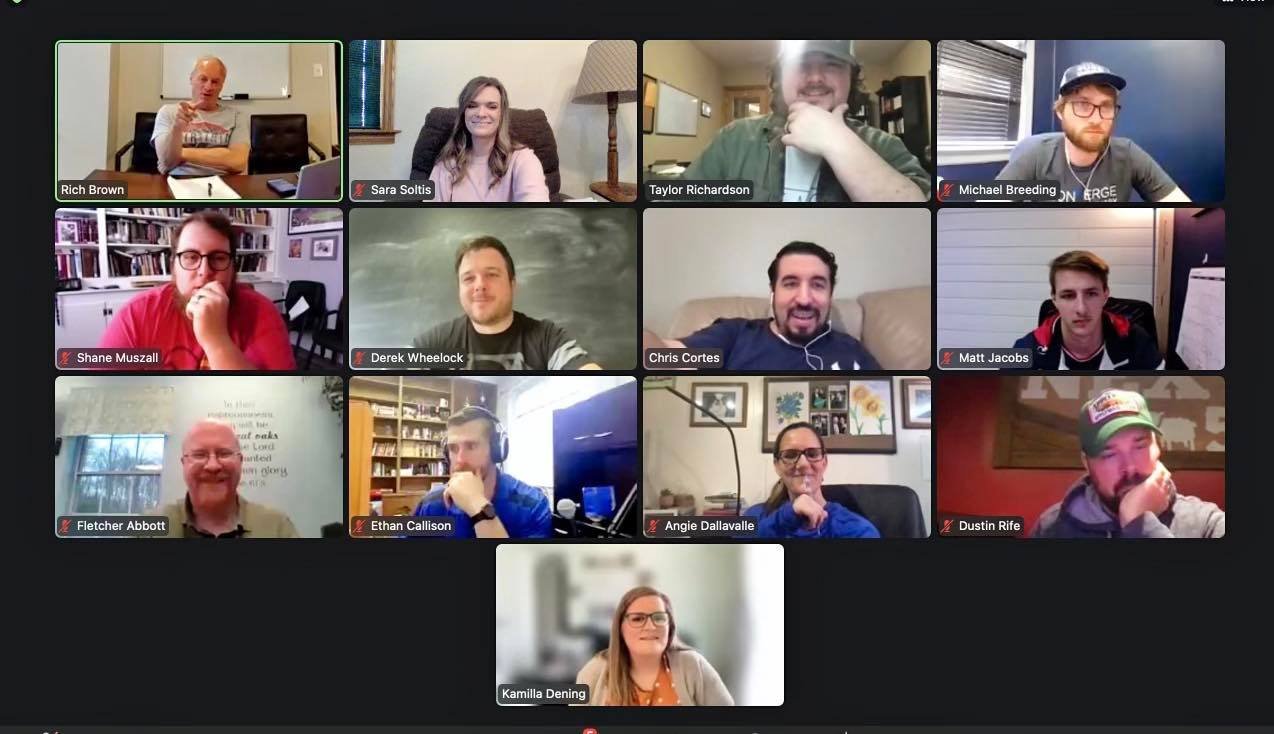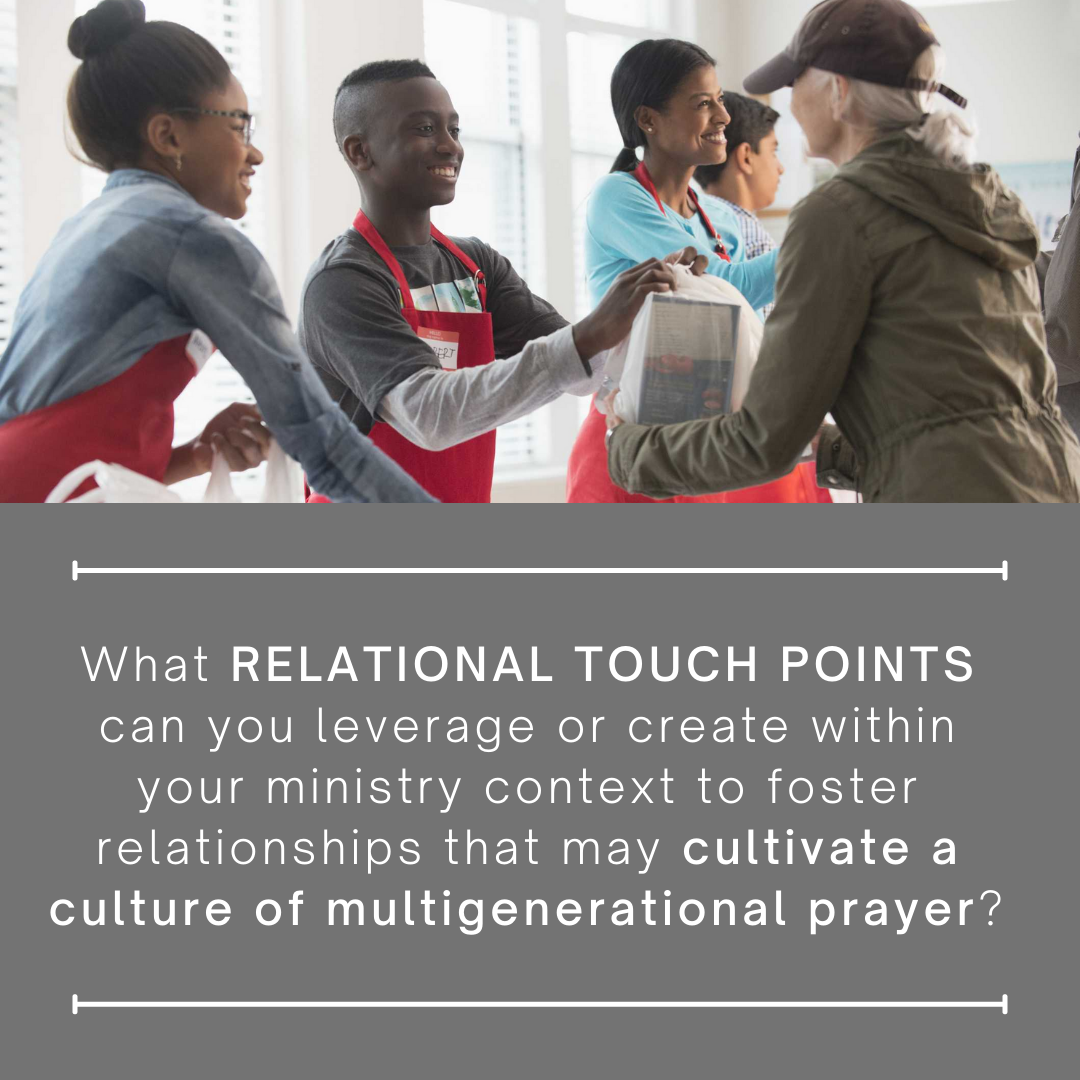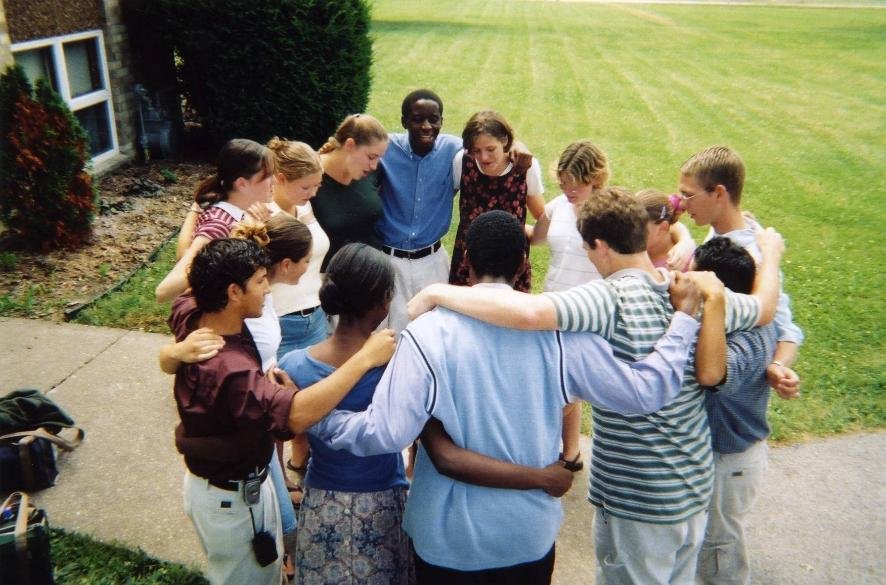Creating a Culture of Multi-Generational Prayer in the Church (pt. 3 in our Prayer Series)
When you look at the next generation, what do you see?
Do you merely see the church of tomorrow or do you see the church of today?
This may seem trivial, yet I believe the way you and I choose to answer this question has the potential to significantly impact how we biblically disciple young followers of Jesus. Yet, beyond this, how we choose to answer this question also has the potential to impact the entire body of Christ. Let me explain.
Up until this final point in NGM’s three-part series on prayer, we have focused on cultivating this spiritual discipline exclusively within the next generation. In part one, we established a biblical basis for prayer and enlisted three basic questions to frame our focus on developing prayer in our students’ lives, including:
Why do we pray?
Why do we not pray?
How do we pray?
In part two, we considered how we can effectively lead our students to pray with and for their generation. While part one and two are certainly essential elements of discipling young Christ-followers, a perspective that exclusively sees the next generation as the church of tomorrow may very well be satisfied to conclude here. However, when we choose to see the next generation as vital members of the church not of tomorrow, but of today, we recognize that the body of Christ is multigenerational and must be unified in every way. Surely, this includes unity in prayer as evidenced time and time again throughout Scripture (Acts 1:14, 2:42; 16:25).
With this understanding, let us consider how we may practically respond in action to cultivate a culture of multi-generational prayer within the body of Christ.
(Photo is one of the two groups from April)
Once again, it is a privilege to call upon the experiences of ministry leaders who collaborated and contributed during NGM’s April Virtual Round Tables on prayer.
It starts with connecting with adults
To begin, perhaps one of the most practical yet challenging aspects of cultivating a culture of multi-generational prayer is related to the limited proximity of all generations in a number of churches today. This limited proximity can all too easily impede the critical relational connections to others within the church physically, socially, emotionally, and spiritually.
As Angie Dallavalle (middle school director of Grace Community Church of Frederick, MD) shared in NGM’s April recent virtual round table, “Prayer is relational — it connects us with God and each other. We need relationships. If our students and our older adults don’t have any relational touch points, then they’re not going to be praying together.” While there is certainly a need for age-related ministries, we, as student ministry leaders, must be on guard to ensure that we do not unnecessarily isolate our students from the church body. Instead, as we seek to establish a firm foundation for cultivating multi-generational prayer, let us foster critical connections or “touch points” that may enhance proximity in an effort to relationally unify all generations.
To do this, consider the following suggestions from these veteran youth ministry leaders:
Dustin Rife: “One of the values at my church is, ‘Authentic community is greater than independent living.’ We try to get as many students as possible serving on Sunday mornings so they can build relationships with others in the church. The more interaction we can get with people face to face the better off they are in sharing prayer requests or praying with others. Everyone also huddles up and prays together prior to serving.”
Kamilla Dening: “Help students build relationships by connecting interests (for example: crocheting, which allows for a connection with older women). Find touch points where interests in the same hobbies align across generations as many of these hobbies are returning from older generations.”
Ethan Callison: “Integrate the next generation in ministry. Every Sunday intergenerational ministry happens where children and students have the opportunity to lead in worship. For example, kids or students will serve and play an instrument or serve as a vocalist. We have to have all generations — the younger generation have that passion, energy, vigor, zeal. While they want to go do things, they need the wisdom and resources of older generations (1 John 2:12-14). Sometimes we place excellence over relationships and diminish the next generation’s service based on ability. We need to give generations opportunities to grow and serve together.”
Imagine mobilizing students to serve at events or gatherings for other age-specific ministries!
For example, encourage male students to set up, serve a meal, or tear down for a men’s breakfast. This places students in proximity with other generations and also allows them to learn how to relate through observation and interaction. This also communicates that all generations are responsible for building relational bridges with one another.
Then moves to connecting with adults in prayer
Next, while relationships will certainly assist in cultivating a culture of intergenerational prayer, the converse is also true as prayer may give rise to new relationships. With this understanding, may we not hold out on intergenerational prayer by waiting for relationships to form. Instead, let’s create and take hold of opportunities that will pave the way for all generations to pray with and for one another by considering these ideas:
Cody Mummau: “We have done the “Pray for Me” campaign launched by Tony Souder. The goal is to enlist one person from each generation above the students to pray for a single student within the church. Students who wanted to have “prayer champions” would then have three prayer champions in the 20-30’s, 40s-50s, and 60s and up. Adults would then take a new student each year.”
Derek Wheelock: “Every 5th Sunday is ‘Family Sunday’ at our church. During this time, we have printed cards with each students’ information. As students stand up front with their card, adults meet the students, agree to pray for them over the next three months, and then move to pray with them right then and there. The adult also receives a reminder card of their commitment to pray for the student over a specific length of time. Then, at the next 5th Sunday, they swap, and the students do the same and pray with and for the adults.”
Rich Brown: “Have a conversation with your lead pastor and those in adult ministries. Together, consider how powerful it could be to have some of your mature, godly students up on stage on a Sunday asking the church how they can pray for them as they communicate, “We love our church, we love you. As students, we want to pray for you. Follow this up with having mature students go into Sunday school classes or small groups and do the same thing. Help students ‘give’ prayer rather than merely ‘get’ prayer.”
Use your church’s current prayer opportunities!
Take inventory of where and when intentional prayer gatherings are taking place with believers in your local church. For example, if there is a regular prayer night, consider reaching out to the person or team who coordinates these gatherings and engage in discussion to include the next generation during these gatherings. Over time, this may create a culture that normalizes multi-generational prayer with believers of all generations rather than viewing it merely as a special occasion.
“As you consider these ideas, what is the next step you can take to practically lead all generations in your local church to regularly pray with and for one another privately and corporately? ”
as students see this modeled in you
Finally, if we are to cultivate a culture of multi-generational prayer, we, as ministry leaders, must lead by example and demonstrate in action that all generations are a priority within our student ministry contexts. As you seek to lead by example, contemplate the following suggestions:
Dustin Rife: “Take the leap and don’t miss opportunities to invite adults to serve in student ministry.”
Matt McClay: “Help student ministry adult leaders establish prayer partnerships with students. This is one of the most logical places to start to bridge multigenerational prayer groups. Provide a Scripture based way for leaders to pray for the students under their care daily.”
Rich Brown: (regarding your leadership team and the weekly ministry times)
o “Ensure your student ministry leadership team is multigenerational.”
o “Invite older couples to come into a midweek gathering. For example, consider a marriage conversation where you invite an older couple that has been married a long time and still hold hands in church. Let them speak to maintaining a love for one another. Or, have older adults talk about walking as a disciple of Jesus. Let’s help create that bridge across generations. Then, after these older adults have shared, invite students to pray over these adults.”
In a multi-generational student ministry, encourage students to take the initiative to pray with and for their leaders. Then, create the space for this to take place regularly. While leaders set the example in prayer with and for their students, let’s challenge our students to selflessly rise to the occasion to pray with and for their leaders that span multiple generations.
As you ponder these suggestions, take time to examine your personal commitment to multi-generational prayer. How are you doing and what can you do next?
How are you leading by example through a personal emphasis on multi-generational prayer?
Consider the ministry’s priority on multi-generational prayer. What is the next step you can take to own this personally?
In what ways can you then call your student ministry to action with regard to multi-generational prayer?
MAKing PRAYER VITAL IN yOUR MINISTRY!
As we wrap up NGM’s three-part series on prayer, know that it has been a true privilege to take this deep dive with you as we considered how to develop students who are committed to the biblically essential spiritual discipline of prayer. Thank you for exploring this with us! It is my sincere hope that in whatever capacity you have joined us, whether through NGM’s virtual round tables, these articles, or even through reading NGM’s recharge blog, that you are encouraged to lead your students so they may come to see just how vital prayer is to a growing and thriving relationship with Jesus. It is also my hope that you will choose to stay connected with NGM and the authentic community developed here through Facebook or Instagram. Be sure to also subscribe to NGM’s newsletter to be alerted of NGM’s upcoming events and free resources available to you and your student ministry team. Hopefully, these articles have helped you to catch just a glimpse of the fruitful collaboration that takes place during our free virtual round tables as fellow student ministry pastors, directors, and volunteers come together from all across the U.S to encourage one another, share experiences, and strategically brainstorm to effectively lead and love the next generation in the truth of Christ. We would be thrilled to have you join us for our next virtual round table so you may experience this community for yourself! Just check out NGM’s events and register to receive the link to join. You are welcome here!
While this marks the end of our series on prayer, our focus and faithfulness to prayer must always remain (Rom. 12:12; Eph. 6:18; 1 Thess. 5:17). Now, as we move forward in pursuit of developing students who are wholly devoted to personal and corporate prayer, may we encourage the next generation to rise to the challenge of prayer as authentic disciples and vital members to the church of today. May our ministries reflect this reality and, in turn, may the church experience the power of God at work in and through multiple generations unified in prayer for His glory and the advance of His kingdom alone.
~ Sara








